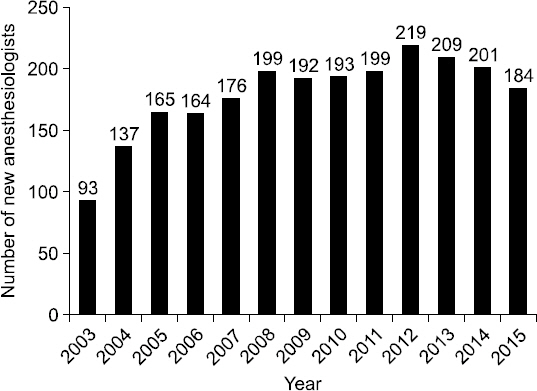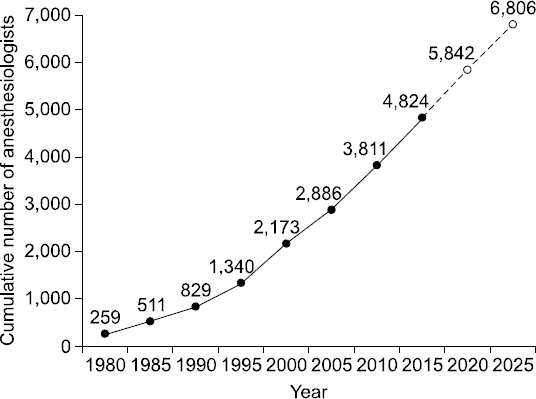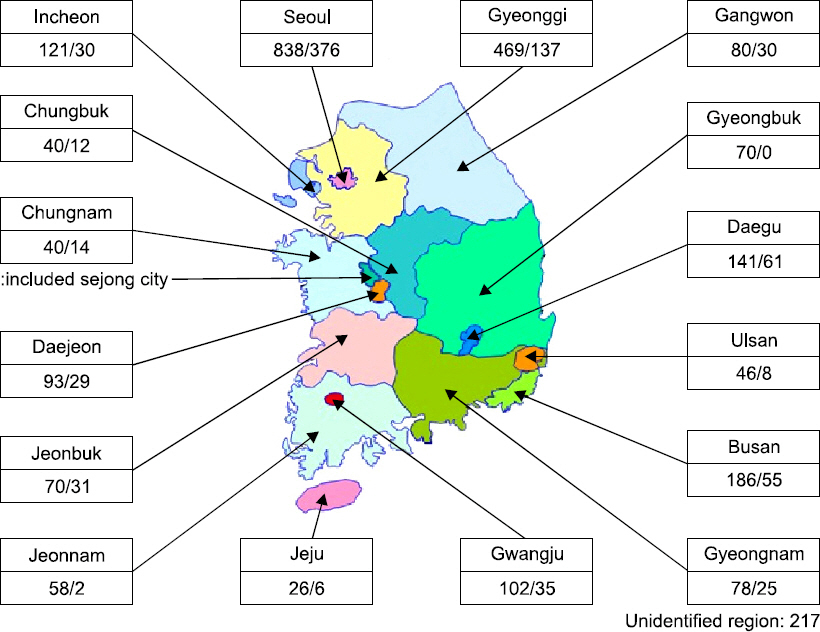Anesth Pain Med.
2016 Jan;11(1):85-90. 10.17085/apm.2016.11.1.85.
Current supply and future workforce projections of anesthesiologists for safe anesthetic care of the Korean population
- Affiliations
-
- 1Department of Anesthesiology and Pain Medicine, Konyang University Hospital, Konyang University College of Medicine, Seoul, Korea.
- 2Department of Anesthesiology and Pain Medicine, Samsung Medical Center, Sungkyunkwan University School of Medicine, Seoul, Korea. dikei@hanmail.net
- KMID: 2169081
- DOI: http://doi.org/10.17085/apm.2016.11.1.85
Abstract
- BACKGROUND
Recently, current or potential shortage and regional imbalance of anesthesiologists have become controversial issues due to political reasons. Thus, we examined the occurrence of current shortage of anesthesiologists in non-capital areas and forecasted the supply of anesthesiologists in the target period between 2020 and 2025.
METHODS
In November 2015, membership data including the type of anesthesia service, age, and regional distribution of the Korean Society of Anesthesiologists (accounting for 73.7% of all anesthesiologists) was renewed. Excepting unidentified members (n = 231), previous data from the 2007 survey were used for analysis. Future workforce projections were determined by adding the number of new anesthesiologists minus the predicted number of anesthesiologists who will retire or die in the targeted period.
RESULTS
In 2015, the cumulative number of anesthesiologists was 4,826. The available anesthesiologists in our country numbered 4,515. Of these, 2,675 anesthesiologists (59.2%) have provided surgical anesthesia services with centralization of the capital region (58.1%). The number of the available anesthesiologists in our country were expected to be 4,585 and 5,478 in 2020 and 2025, respectively.
CONCLUSIONS
The regional distribution of anesthesia services reported by the Health Insurance Report indicated a current centralization of anesthesiologists in the capital region, as a result of anesthesia demand concentration in this area. The age composition of current anesthesiologists as well as the numeric trends of trainees acquiring professional license indicated a stable supply of anesthesiologists over the next 10 years.
Figure
Reference
-
1. Roberfroid D, Leonard C, Stordeur S. Physician supply forecast: better than peering in a crystal ball? Hum Resour Health. 2009; 7:10. DOI: 10.1186/1478-4491-7-10. PMID: 19216772. PMCID: PMC2671486.
Article2. Shin SR, Oh PJ. A Study on the demand for nurse anesthetists in Korea. J Korean Acad Funda Nurs. 2004; 11:195–202.3. Kim KR. Advanced practice nurse system and unlicensed medical practice. Korean J Leg Med. 2010; 11:173–98.4. Lee SG, Kim JM. Study on current state of anesthesia practiced for patient safety (research paper funded by the Korean Society of Anesthesiologists). Yonsei University Industry Foundation and the Korean Society of Anesthesiologists. 2014.5. Statistics Korea, Vital Statistics Division. Causes of death statistics in 2013 [Internet]. 2014. Sep. 23. cited 2015 Dec 2. Available from http://kostat.go.kr/portal/korea/kor_nw/2/6/2/index.board? bmode=read&bSeq=&aSeq=330181&pageNo=1&rowNum=10&navCount=10&currPg=&sTarget=title&sTxt=.
- Full Text Links
- Actions
-
Cited
- CITED
-
- Close
- Share
- Similar articles
-
- Adequacy of the physician workforce for preparing for future society in Korea: an English translation
- Variables in the projection of physician demand and supply in primary care
- The future prospects of supply and demand for urologists in Korea
- The Demand and Supply of Nutritionist Workforce in Korea and Policy Recommendations
- The state of anesthesia in South Korea: a national survey of the status of anesthetic service activity in 2014–2016




